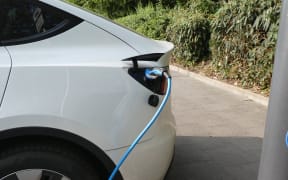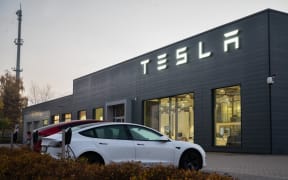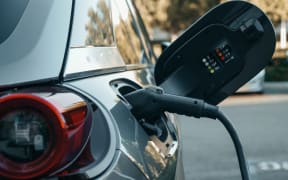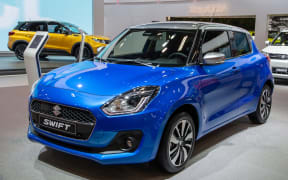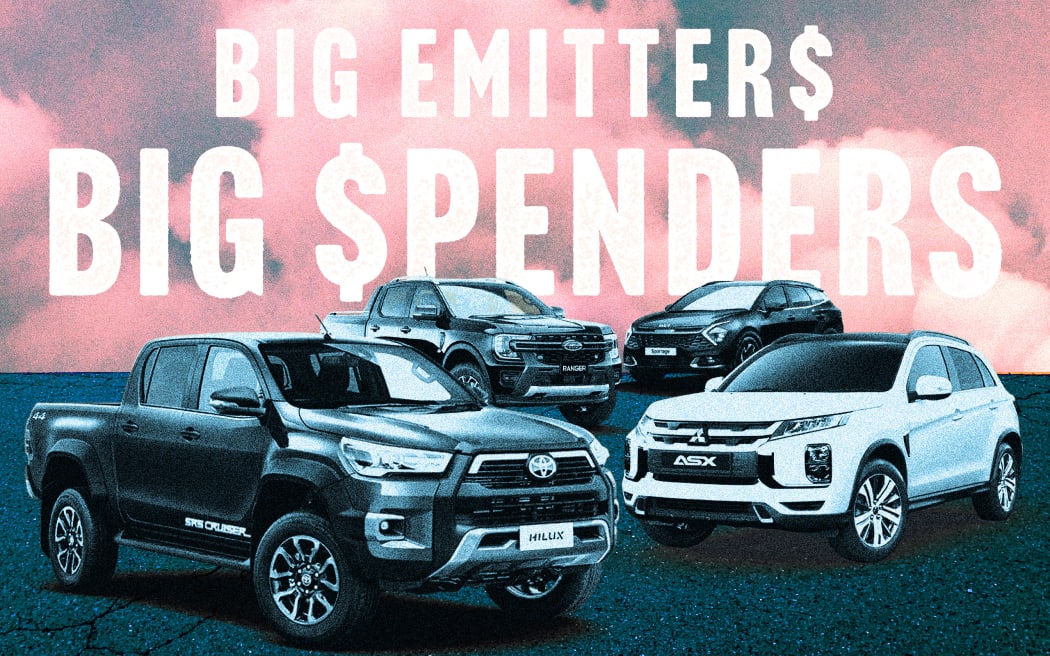
The vehicles with the highest advertising spend in the past three years were all utes or SUVs. Photo: Screenshot / Unsplash / RNZ
'Industry hype' about electric vehicles isn't matched by the money car makers are spending promoting them. Instead, the biggest gas guzzlers still get the biggest advertising dollars.
Car companies are spending almost four times more advertising large, gas-guzzling vehicles than small cars, despite publicly pledging to combat climate change.
Advertising figures from data company Nielsen show that while the spend on electric vehicles and hybrids is increasing, the vehicles with the most advertising grunt behind them are utes and SUVs.
Toyota spent the most of any company selling a single vehicle. According to Nielsen, it paid $7.6m over the three years to 2022 on its signature double cab ute, the Hilux.
This is despite Toyota's stated aim of reaching carbon neutrality by 2050 and its public promise to "shape a better tomorrow, together". It also privately wrote to former Prime Minister Jacinda Ardern praising her work on climate change.
"At Toyota we will continue in our efforts to reduce our vehicle emissions and provide the safest technology that is affordable for Kiwis," Toyota chief executive Neeraj Lala wrote in a 2021 email, obtained by RNZ using the Official Information Act.
Toyota wasn't alone in pushing its favourite large vehicle. Its rivals Mitsubishi, Ford, Kia and Hyundai all spent similar amounts promoting their utes and SUVs.
The advertising spend clearly paid off - as of 2022 the Hilux and fellow beloved double cab ute the Ford Ranger remained New Zealand's most popular new cars - a complete turnaround from a decade ago when the humble Toyota Corolla was more likely to take the number one spot.
The emissions problem with utes and SUVs
Transport pollution makes up about 40 percent of New Zealand's carbon emissions, and is one of the country's top priorities in fighting climate change. A 40 percent reduction on 2019 emissions levels is required by 2035.
Large vehicles like utes and SUVs make a substantial contribution to those emissions, according to researchers from the University of Auckland, who found utes emit about 1.5 times as much carbon as light cars.
"The reason that more people driving SUVs is bad for the climate is because for a while the cars were getting more efficient, and smaller and so our emissions were dropping," said Dr Kirsty Wild, an environmental sociologist and public health researcher. "But then we made a switch to these bigger vehicles, just as we've started to turn things around for the climate."
Research by Wild and her colleagues found a link between consumer trends and advertising. Not only were more people driving SUVs and utes, but they tended to drive them more than those who had smaller cars.
While the larger vehicles were designed for carrying and towing, owners weren't necessarily using the vehicles for those purposes. About two thirds were registered for personal use, in cities, to pick up the kids or do the shopping, for example - used in the same way you'd use a regular car.
"And people are going similar distances in them too," Wild said. "So the majority of trips are less than five kilometres, about 12 percent of trips are less than a kilometre. So that's someone going to the dairy."
Advertising and the climate
Tim Welch, a senior lecturer in urban planning at the University of Auckland, said part of the push towards SUVs and utes was the profit margin, which was much higher when compared to a typical sedan, or an electric vehicle.
Welch said there was a gap between "industry hype" about electric vehicles and what was actually happening.
"There's a lot of splashy advertising when it comes to what car makers say they're spending in developing more sustainable modes of transport," Welch said. "But the reality is that we haven't seen significant movements in emission reductions for many car companies."
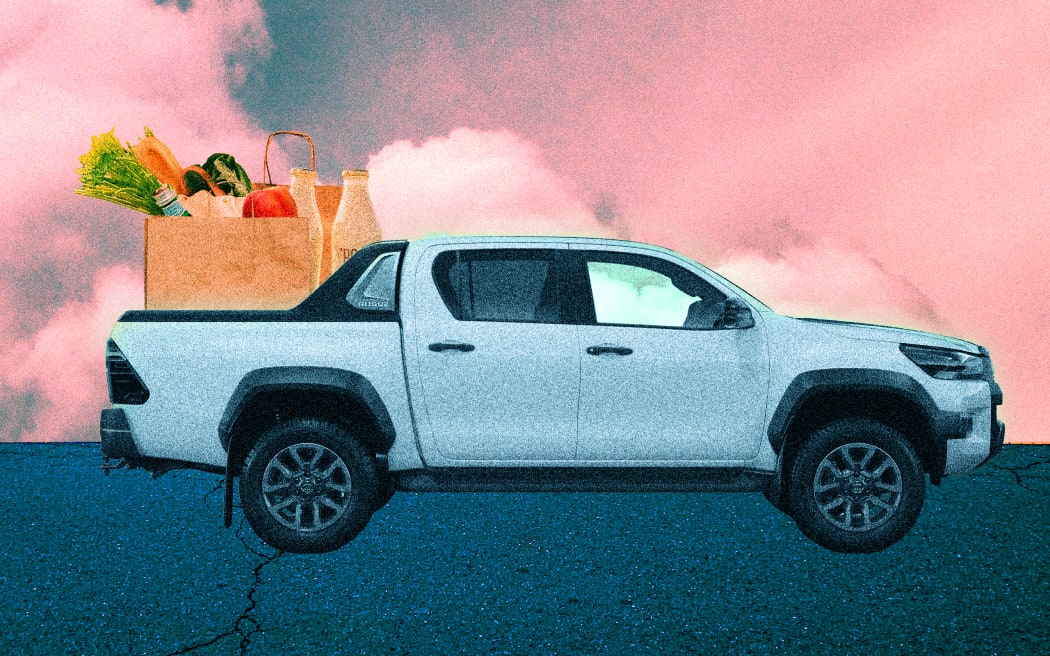
Double-cab utes are marketed as being hard-wearing, tough vehicles for taking on wild conditions. Most of them are used just like regular cars. Photo: Screenshot / Unsplash / RNZ
There was "pretty limited" access to fully-electric vehicles in New Zealand, and even some limits on hybrid vehicles, Welch said.
In Europe and the US, the advertising spend on petrol or diesel vehicles is 20 times that of electric vehicles.
And in Australia, Toyota is being sued for overstating the efficiency of its hybrid vehicles.
Where advertisers were spending on electric or hybrid vehicles, it was most likely to be their electric SUV ranges, rather than on smaller models like the Nissan Leaf or Toyota Yaris, Welch said.
Car makers respond
When asked why it was marketing the Hilux so aggressively amid a growing climate crisis, Toyota said that the ute "met a specific market need that other models don't".
The Hilux spend was a small proportion of its total marketing spend, most of which went on brand, corporate engagement, sponsorship and brand ambassadors, "all of which are driving the greater take-up of low-emitting hybrids."
Toyota said half its sales were hybrids, and the Hilux hybrid was due in New Zealand before the end of the year.
"Our sustainability goals are to reduce our impact on the environment and society," the company said in a statement.
"We are doing that by advertising and selling low-emitting hybrids, battery electric vehicles and operating low-emitting car sharing schemes. We also acknowledge that Hilux and similar vehicles continue to play a not-so-small role in keeping New Zealand's rural and commercial economies moving."
Ford said it was now spending "as much or more" advertising its new electric vehicles as its Ranger.
"I can't speak for other brands but in our view, the industry spend reflects both a very competitive market as well as Kiwi consumer preferences, which again includes more and more electrified vehicles," Ford New Zealand spokesman Tom Clancy said.
Ford was on track to achieve its goal of carbon neutrality no later than 2050.
Clancy questioned why RNZ was focusing on vehicle companies.
"New Zealand has made serious strides in this area and will continue to do so - Ford included. Are you asking airlines why they still advertise?"
In a follow-up email, he said he was surprised there was not a story planned about cruise ship emissions either.
Advertising restrictions
Other countries have recently made moves to curb advertising in response to the warming planet. France has banned advertisements of petroleum energy products, energy from the combustion of coal mining, and hydrogen-containing carbons.
A recent UK study recommended a ban on advertising for the top-third of polluting vehicles, and new advertising codes to regulate fossil fuel promotion, including a voluntary code for advertising agencies.
In Australia, nearly 100 marketing, advertising and PR companies have signed a pledge against promoting pollution. The group, called CommsDeclare, asks members not to promote the growth of any of Australia's largest greenhouse gas polluters, such as energy and mining companies.
New Zealand's Commercial Communications Council chief executive Simon Lendrum said he wasn't aware of any such moves locally. Instead, the industry had launched Ad Net Zero, which was an initiative focused on reducing carbon in the advertising supply chain.
Lendrum said it preferred to work with the automotive industry as it transitioned to electric vehicles.
Car advertising is the second biggest advertising sector in New Zealand.

